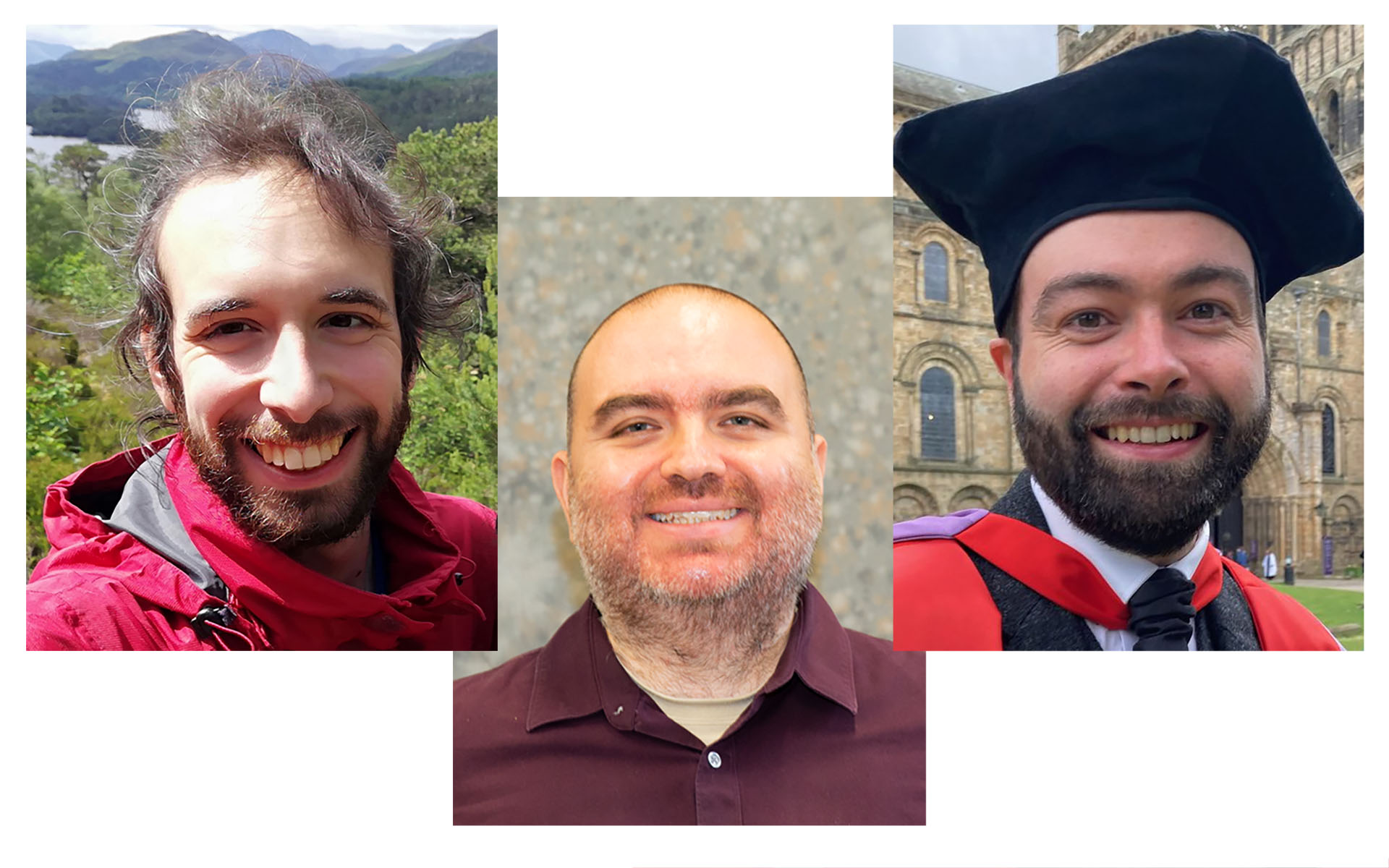Physics Department Developing Talent Award 2023 Winners

The Physics Department Developing Talent Award promotes, enhances and encourages the possibility of early career researchers developing their research careers within the Department by providing up to £10,000 in flexible funding.
The three successful applicants in the 2023 round of this scheme are:
Dr Daniele Sorini (ICC) - How do cosmology and galaxy formation shape the matter content of galactic haloes? (pictured left above)
Dr Julius de Rojas (CMP) - Growing 3D Magnonic Networks for Neuromorphic Computing (pictured above, at centre)
Dr Liam Gallagher (QLM) - Improving the efficiency of nonlinear optical processes in Cu2O (pictured right above)
More information about each applicant and their research
Dr Daniele Sorini (ICC) - How do cosmology and galaxy formation shape the matter content of galactic haloes?
The energy budget of the Universe is split between baryonic (i.e., “ordinary”) matter (5%), invisible but gravitationally interacting dark matter (27%) and an unknown form of dark energy (68%). Galaxies form within spheroidal haloes, which generally contain a smaller baryonic-to-dark-matter mass ratio than what would be expected from the cosmic budget. Simulations suggest that the “missing baryons” could be pushed outside haloes by winds driven by supernovae explosions or jets from the central black hole of the galaxy. It is not yet clear how the different astrophysical processes interact to determine how far baryons can migrate. If the cosmic budget of baryons, dark matter and dark energy were different, would haloes still be baryon deficient?
I will work with an undergraduate student during the summer to understand how different astrophysical processes and the cosmological model conspire in shaping the baryonic content of haloes. This will be achieved by combining a novel analytic model for the baryon mass fraction of haloes in arbitrary cosmologies that I recently developed, and a suite of state-of-the-art cosmological hydrodynamic simulations.
Dr Julius de Rojas (CMP) - Growing 3D Magnonic Networks for Neuromorphic Computing
Deep Learning forms the basis of emerging technologies such as image recognition, self-driving vehicles, and natural language processing. Deep Learning relies on algorithms to perform pattern recognition on large data sets using artificial neural networks which mimic the biological brain, known as neuromorphic computing. However, current computer hardware, while excellent at quickly performing sequential tasks, is ill-suited to meet the demands of cutting-edge neural networks, and a flurry of research has moved towards components better able to mimic neurons and synapses. Magnonics, an emerging technology in which information can be stored in the amplitude and phase of magnetic spin-wave, is a promising neuromorphic candidate.

In this project, I will tackle one limitation of magnonic circuits: efficient fabrication of large, interconnected 3D networks. I will use electrochemical deposition to grow ferromagnetic nanowires with periodic defects suitable with for magnonic circuit applications, acting as a ‘magnonic’ crystal which controls the properties of the traveling spin wave. I will then extend this technique to ion-etched templates to form 3D integrated nanowire networks. The goal is for these networks to form truly 3D networks of many layers, connected like multi-layered neuron and synapses.
Dr Liam Gallagher (QLM) - Improving the efficiency of nonlinear optical processes in Cu2O
In the semiconductor Cu2O, very highly excited states of excitons (bound states of electrons and holes) exist. As higher energy excitonic states are exited, many properties of the excitons scale, leading to large dipole moments and long-range interactions when compared to ground state excitons. The exaggerated properties of the highly excited states have led to Cu2O being proposed as platform for solid-state quantum optics. One of the outstanding challenges in this material is the influence of absorption features related to phonons. Nonlinear spectroscopy of excitons in this material seems to avoid many of the problems related to phonons and has proved a promising avenue of research. However, the current nonlinear spectroscopy techniques are very inefficient.
The aim of this project is to try and address the inefficiency of nonlinear optical processes in this material. For this, I am collaborating with Dr Hamid Ohadi at the University of St Andrews, who is an expert in microfabricating Cu2O. The idea is to construct a microcavity around the Cu2O sample with the goal of improving the efficiency of the nonlinear optical processes.

Left: Cu2O gemstone which we cut and polish samples from. Right: Exciton absorption spectrum from Cu2O. Dark lines are different exciton resonances.


/prod01/prodbucket01/media/durham-university/departments-/physics/teaching-labs/VT2A9034-1998X733.jpeg)